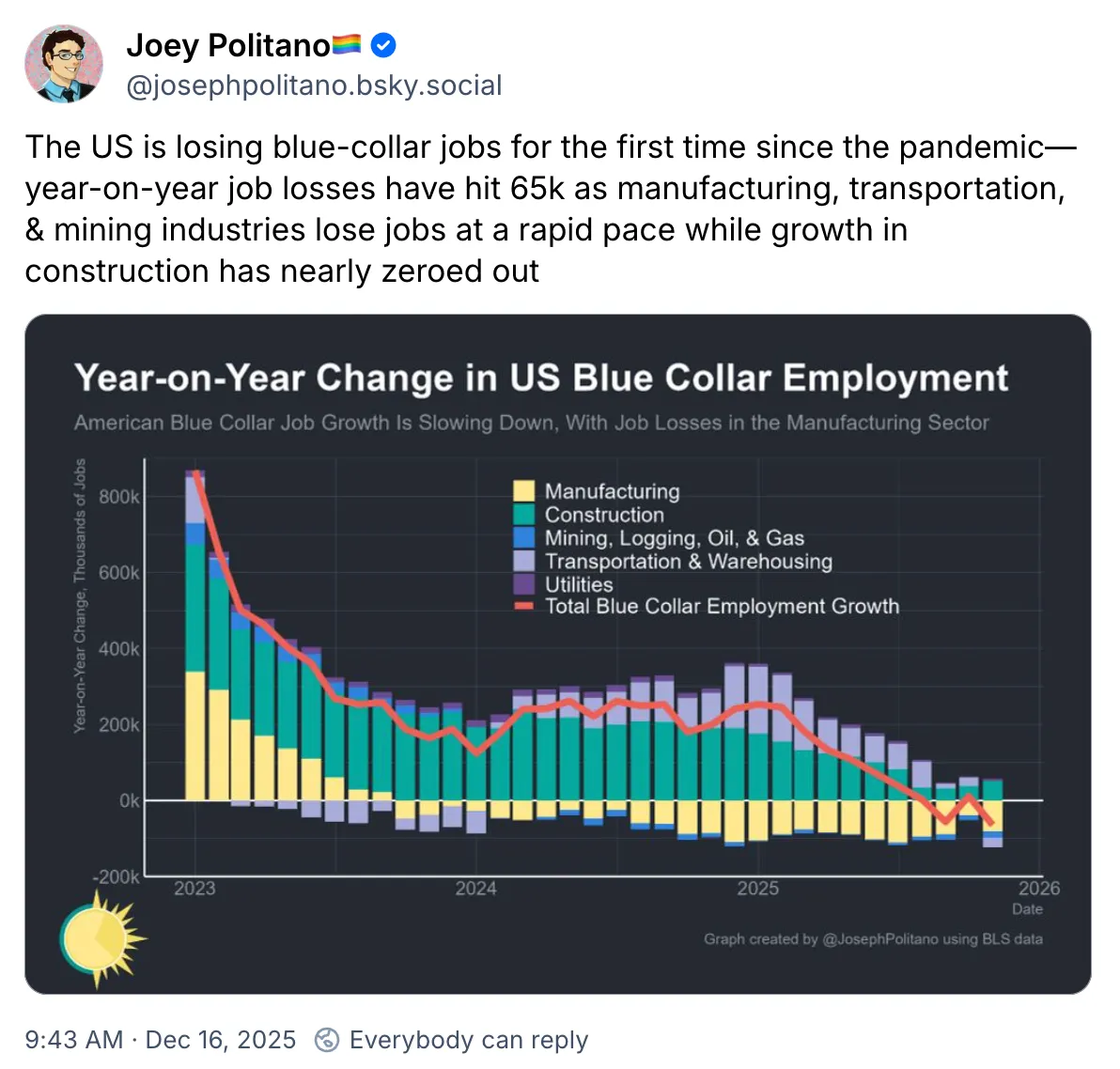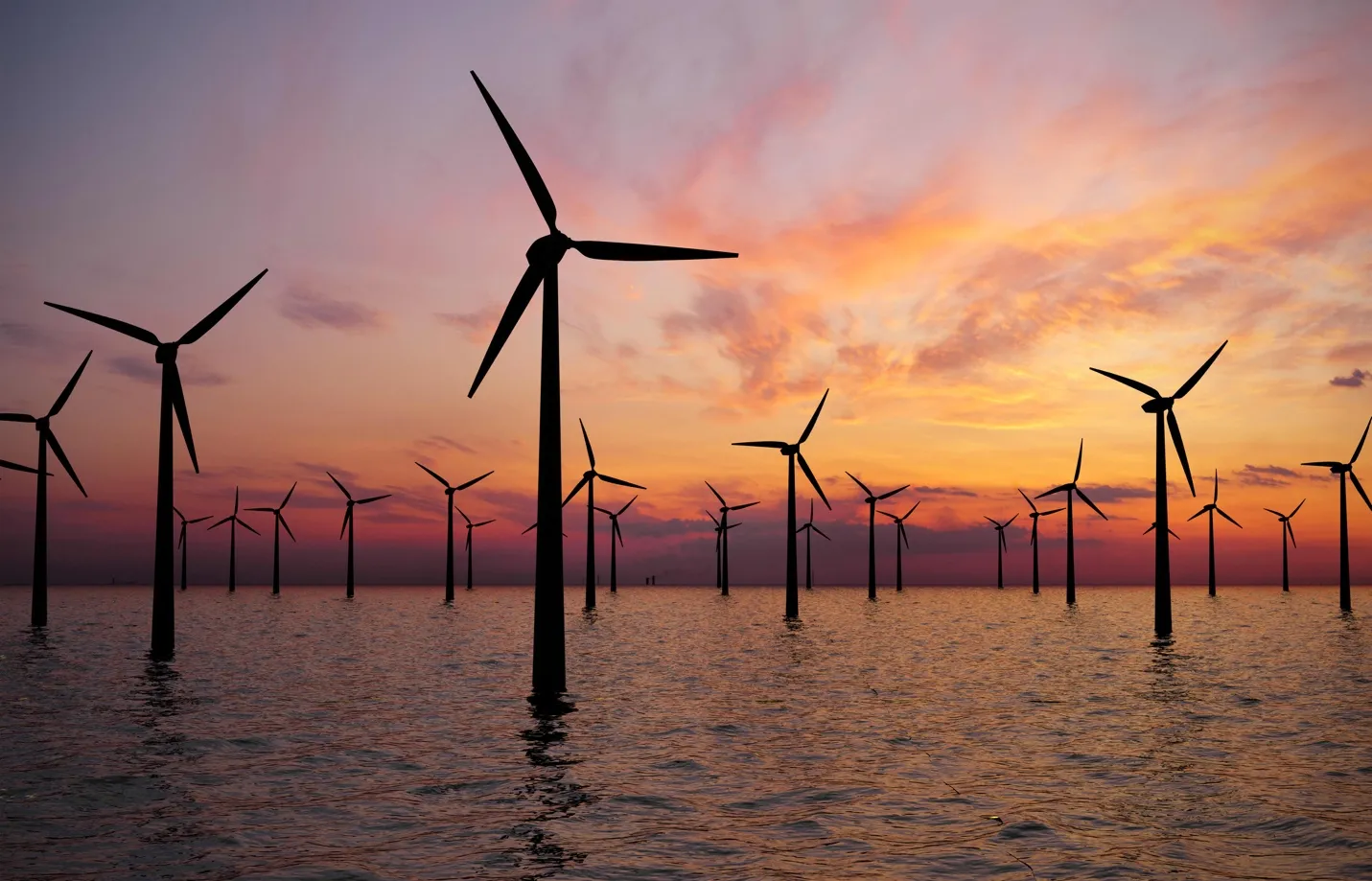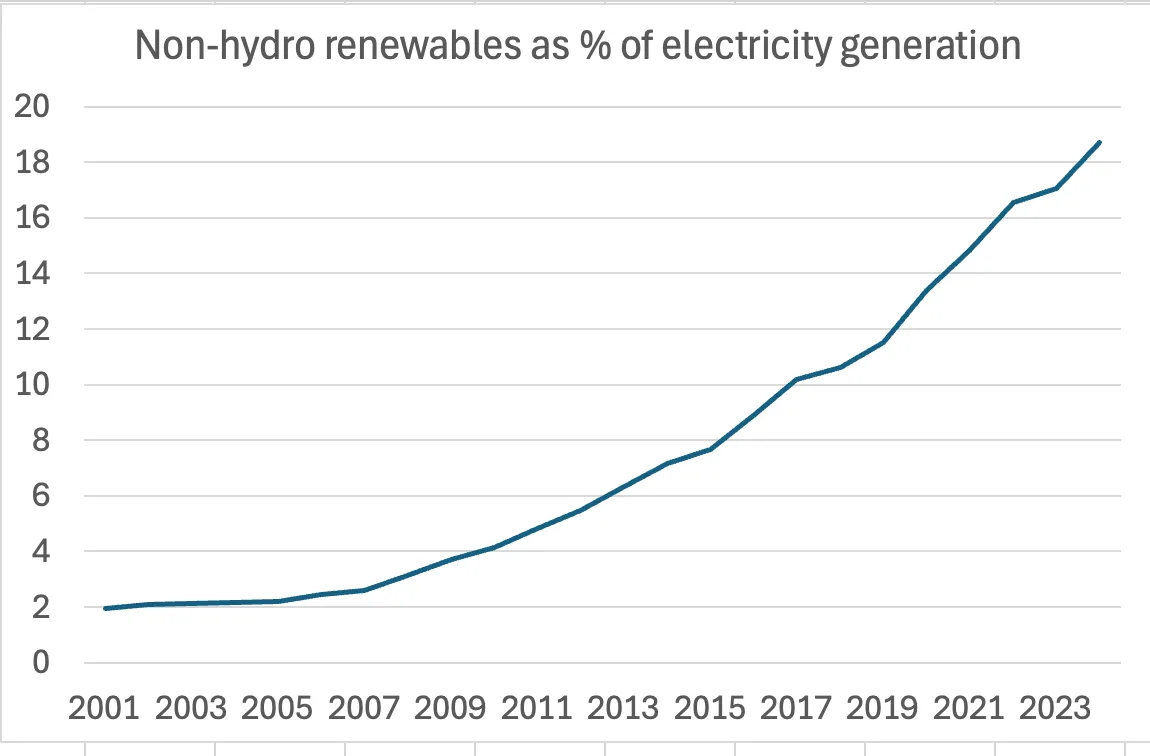India’s exports increased by nearly 20 percent in November year-on-year, the country’s fastest growth in three years, driven primarily by exports to the United States and China.
............ The November rise in Indian exports also comes as China recorded a trade surplus of more than $1 trillion, in part reflecting how global trade flows are being reshaped as a result of the Trump trade wars. .......... The export figures, reported this week by India’s Ministry of Commerce and Industry,reflected resilient demand for Indian goods
and a strategy of diversifying to new export markets, the ministry said, an approach other countries are also adopting as they look to reduce reliance on the US. ...............key drivers for strong exports included engineering goods, electronics and pharmaceuticals.
............Despite the new tariffs, India’s exports to the US – its largest single destination – grew by 22 percent in November, reaching approximately $7bn.
................ The healthiest export sectors were engineering, electronics, jewellery and gems, and pharmaceuticals. ................... “India has held fort on the US exports despite tariffs,” Commerce Secretary Rajesh Agrawal said ............ shipments to China surged by 90 percent year-on-year to $2.2bn. China recorded notably higher Indian imports, with electronics and engineering goods seeing sizeable increases. ........... exports to Spain, the United Arab Emirates and Tanzania were also driving growth. ......... “India’s exports of electronics and pharmaceuticals to the US increased, and these product categories are exempt from tariffs. Furthermore, tea, coffee, spices and other food items were also added to the exemption list, and all of them are experiencing steady growth.” ............ analysts also say continued healthy exports to the US signal that traders expect it to eventually relax tariffs on other goods, as the two countries are still working towards a trade deal. ........... While the Trump administration claimed earlier this year that India had agreed to stop buying discounted Russian oil, it has shown little sign of doing so. ............. India has also resisted US pressure to open up sensitive sectors such as agriculture and dairy to US imports, insisting it will protect farmers and not “bow down” to tariff demands, while Trump is demanding greater market access. ........... In July this year, India and the UK signed the Comprehensive Economic and Trade Agreement under which tariffs have been reduced. Last year, India also signed the Trade and Economic Partnership Agreement with the European Free Trade Association countries – Switzerland, Norway, Iceland and Liechtenstein – under which they have linked markets in return for investment. ................. India is currently in talks with Mexico to counter tariff policies there and create new export corridors. Mexico’s Senate on Wednesday approved tariff hikes of up to 50 percent from January on imports from India and other countries, a move analysts say is aimed at appeasing Washington. ............ India would also be looking to diversify into Eurasian and Central Asian markets ............ Beijing has weathered the standoff by increasing exports to non-US markets ............ China’s exports to the European Union also saw strong growth, up an annual 14.8 percent in November year-on-year, and an 8.2 percent rise in exports to countries in Southeast Asia. ........... Vietnam has also registered export increases in 2025, with its trade surplus with the US reaching $121.6bn over the same period, despite the 20 percent tariffs imposed on its goods by the Trump administration. ............. “Countries are looking to diversify away from the US into Asian markets such as China, Japan and ASEAN. Trade deals is one way of ensuring trade and reducing trade uncertainty. Incentivising investments and opening up markets is also another way of securing trade.” ...............Canada’s Prime Minister Mark Carney has previously said Canada aims to double its non-US exports over the next decade.
Thousands of U.S. farmers have Parkinson’s. They blame a deadly pesticide.
Bush v. Gore in retrospect the decision’s largest significance may be from the widespread perception that the justices were simply motivated by their own partisan preferences as to who should be the next president.......... The presidential election of Tuesday, Nov. 7, 2000, was one of the closest in American history. By early Wednesday morning it was clear that the Democratic candidate, Vice President Al Gore, won the national popular vote but that the outcome of the electoral vote was uncertain. The presidency turned on Florida and its 25 electoral votes. ..................... The Florida Supreme Court ordered that there be a count of all uncounted ballots in the state and appointed a state court judge, Terry Lewis, to oversee this. Just hours after the Florida Supreme Court’s decision, Lewis ordered that the counting of the uncounted votes commence the next morning and that it be completed by Sunday afternoon, Dec. 10, at 2:00 p.m. ............ On Saturday morning, counting commenced as ordered. At the same time, Bush asked the Supreme Court to stay the counting and grant certiorari in the case. In the early afternoon on Saturday, the court, in a 5-4 ruling, stayed the counting of the votes in Florida. ........... On Monday, Dec. 11, the justices held oral arguments. On Tuesday night, Dec. 12, at approximately 10:00 p.m., the court released its opinion in Bush v. Gore. ............ The per curiam opinion was made up of the five most conservative justices: Chief Justice William Rehnquist and Justices Sandra Day O’Connor, Antonin Scalia, Anthony Kennedy, and Clarence Thomas. ............. Specifically, the court said that the central problem was that the Florida Supreme Court ordered the counting of the uncounted ballots, but failed to prescribe standards for how to do so. The court said that this results in similar ballots being treated differently. The court thus concluded that counting the uncounted ballots pursuant to the order of the Florida Supreme Court would deny equal protection .............. The court, in its per curiam opinion, said that Florida indicated that it wished to observe the Dec. 12 date set by federal law. The court thus ordered an end to the counting. .................... Each of the four dissenting justices – John Paul Stevens, David Souter, Ruth Bader Ginsburg, and Stephen Breyer – wrote vehement dissents. Stevens, for example, stated: “The endorsement of [the] position by the majority of this court can only lend credence to the most cynical appraisal of the work of judges throughout the land … Although we may never know with complete certainty the identity of the winner of this year’s Presidential election, the identity of the loser is perfectly clear. It is the Nation’s confidence in the judge as an impartial guardian of the rule of law.” ............... In hindsight, the decision seems clearly wrong. ............ Second, even if there was an equal protection violation, the Supreme Court erred in ending the counting of votes rather than remanding the case to the Florida Supreme Court to decide, as a matter of Florida law, whether to count the uncounted votes or stop the recount. ............ The widespread perception (which persists to this day) was that the court’s decision was less about the law and much more about the political views of the justices. ............. The court’s recent ruling on Dec. 4, in Abbott v. League of United Latin American Citizens, is indicative of the conservative justices’ desire to keep the federal courts out of elections. The court reversed the lower court and allowed Texas to use a new map for congressional districts that likely creates five more Republican districts, despite detailed findings that race was impermissibly used in creating the districts in violation of equal protection. Animating the majority’s opinion was a desire for deference to the political process and for federal courts to not be involved in changing the rules for elections. ....... Or has the last quarter century only heightened our sense of the partisanship of the court and made it unthinkable that today’s conservative majority would come out any differently from the conservative majority in Bush v. Gore?
In this secret missile factory, Ukraine is ramping up its domestic arms industry
A Starlink satellite just exploded and left 'trackable' debris SpaceX says it presents no threat to the ISS or its crew. .......... The incident happened just days after a Starlink satellite narrowly avoided a collision with a rival Chinese satellite from CAS Space last week. Starlink vice president Michael Nicholls said that the incident happened due to a lack of coordination between the two companies. "When satellite operators do not share emphemeris for their satellites, dangerously close approaches can occur in space," he wrote on X. ....... Starlink's constellation consists of almost 9,300 active satellites making up around 65 percent of all orbiting spacecraft, not including defunct units. That number grew by more than 3,000 this year alone, launched aboard 121 separate SpaceX missions — around one every three days.
On December 17, Starlink experienced an anomaly on satellite 35956, resulting in loss of communications with the vehicle at 418 km. The anomaly led to venting of the propulsion tank, a rapid decay in semi-major axis by about 4 km, and the release of a small number of trackable…
— Starlink (@Starlink) December 18, 2025
This has been the craziest year professionally. I'm lucky to be able to do two of my passions: building and investing in crazy good founders. Some updates:@elevenlabsio
— Carles Reina (@Carles_Reina) December 19, 2025
▫️We reached $6.6bn valuation and crossed $300m ARR
▫️I visited customers & our teams in 16 countries…
AI + Marketing = A Solara https://t.co/clyBfdaY0F #pleaseinvest
— Paramendra Kumar Bhagat (@paramendra) December 19, 2025
Pitching Shruti Gandhi For A Solara https://t.co/JTmADVQg9R
Pitching Neil Patel To Come In As A Co-Founder https://t.co/JyeMAB6UmV
Today we just installed the fourth CNC machine on our shop floor which was built entirely in-house.
— Vishakh Ranotra (@VishakhRanotra) December 19, 2025
If we hadn’t invested years into R&D and machine development, we’d still be importing this equipment and sending thousands of dollars out of the country for the same capability.… pic.twitter.com/qqdIFz3wjf
What are your export volumes? Which are your major destinations?
— Paramendra Kumar Bhagat (@paramendra) December 19, 2025
I'm incredibly proud that Flock Safety played a key role in working with first responders to find the suspect in the Brown and MIT murders.
— Garrett Langley (@glangley) December 19, 2025
America cannot tolerate tragedies like what we saw at Brown and MIT this past week. The single best way to curb crime is to make sure…
Congrats.
— Paramendra Kumar Bhagat (@paramendra) December 19, 2025
Guess I need to work out
— Elon Musk (@elonmusk) December 19, 2025
Guess you do.
— Paramendra Kumar Bhagat (@paramendra) December 19, 2025
The Dawn Beyond Currency (Part 1) https://t.co/hluU2KBFZr
— Paramendra Kumar Bhagat (@paramendra) December 19, 2025
The Dawn Beyond Currency (Part 2) https://t.co/GmaTmsdWEw
Product Managers and Designers who can code well with an agent are going to be the most valuable people in tech in 2026.
— Ryan Carson (@ryancarson) December 18, 2025
Hello from West Texas.
— Paramendra Kumar Bhagat (@paramendra) December 19, 2025
AI + Marketing = A Solara https://t.co/clyBfdaY0F #pleaseinvest
— Paramendra Kumar Bhagat (@paramendra) December 19, 2025
Pitching Shruti Gandhi For A Solara https://t.co/JTmADVQg9R
Pitching Neil Patel To Come In As A Co-Founder https://t.co/JyeMAB6UmV
Congrats. Now angel invest.
— Paramendra Kumar Bhagat (@paramendra) December 19, 2025
AI + Marketing = A Solara https://t.co/clyBfdaY0F #pleaseinvest
Pitching Shruti Gandhi For A Solara https://t.co/JTmADVQg9R
Pitching Neil Patel To Come In As A Co-Founder https://t.co/JyeMAB6UmV
genz are making +$10k/month showcasing ai tools on tiktok
— Jeddi (@antinertia) December 19, 2025
it’s gonna be hard to hire them
market is ultra hot, companies (me included) are paying a shit ton of money to these creators
if you have no clue what you want to do and don’t want a boss
create ai flows & show them on…
Less than a year later:
— Ben Lang (@benln) December 18, 2025
• Cursor: $1B ARR w/ 250 people
• Lovable: $200M ARR w/ 100 people
• Mercor: $500M ARR w/ 200 people https://t.co/0amfi2Xz0E
I offer to write a novel on the future of Cursor, far future. Please sponsor. 30K.
— Paramendra Kumar Bhagat (@paramendra) December 19, 2025
Sample: Six Weeks From Zero https://t.co/PEZEon22Chhttps://t.co/PdWN4Sg650 pic.twitter.com/tCD6bytD75
My portfolio is getting way too good way too fast 😵💫
— Theo - t3.gg (@theo) December 18, 2025
Congrats to Anton and the team at Lovable! https://t.co/3ZNLwpMPNz
Same to you. The WTO is dead. Work on the replacement.
— Paramendra Kumar Bhagat (@paramendra) December 19, 2025
Rethinking Trade: A Blueprint for a Just Global Economy https://t.co/DQjyAqgscB
Rethinking Trade: A Blueprint for a Just and Thriving Global Economy https://t.co/8aGH1VhAMj
The problem is the Y axis. It has been designed to make the curve steep.
— Paramendra Kumar Bhagat (@paramendra) December 19, 2025
40, 30, 20 and 10.
— Sterling Crispin 🕊️ (@sterlingcrispin) December 18, 2025
Some advice to younger people, make time to enjoy your life, with balance and moderation. Don't lose yourself to addictions society has normalized. Overworking, doom scrolling, gambling, video games, drugs, alcohol, they'll steal your life if you let them.… pic.twitter.com/2G5hfabQ1k
if im at a party and someone asks for my linkedin, im like damn you must hate me
— Linda Chen (@linderps) December 18, 2025
Easy to see the $11T global TAM of the construction industry and assume its ripe for technology. While that may be true, there are less than a handful of companies who have successfully succeeded in serving some segment of the market (Procore, Built Technologies, Plangrid, Kojo).… pic.twitter.com/LlHZVdp7WO
— Nichole Wischoff (@NWischoff) December 18, 2025
> be wife
— vittorio (@IterIntellectus) December 19, 2025
> FAANG software engineer
> 15 minutes into maternity leave
> already making organic beeswax candles
> no toxins, no scents, just light
> wants to quit tech to start a candle business
> "you'll let me run it at a loss right"
i love her so much
Me.
— Paramendra Kumar Bhagat (@paramendra) December 19, 2025
Announcing our $330M Series B 🦄
— Elliot Lindberg (@robiot) December 18, 2025
We're now valued at $6.6 billion
This company moves at crazy speeds that neither you nor I have seen anywhere else before 🤷
As you might remember: I was seventeen when I joined this company, back when it was still a mini-startup with only… pic.twitter.com/q4zA2mecJr
I'm gonna be a software engineer intern at Google in NYC holy shit
— chiuce (@CHIUCE7) December 18, 2025
my favourite little corner of the world: where i write my books pic.twitter.com/kKjbSgFQxx
— Dr David Vernon (@DrDavidVernon) December 18, 2025
Vib (@Vbob202) cofounded a $4B autonomous boat company, and I finally got him out of the office long enough to talk about it.
— Zabie Elmgren (@zabie_e) December 19, 2025
As CTO at @Saronic he’s had to:⁰• scale 4 → 1,000 people in 3 years⁰• align hardware, software, & systems teams⁰• get new hires up to Saronic… pic.twitter.com/214pgSvwHB







